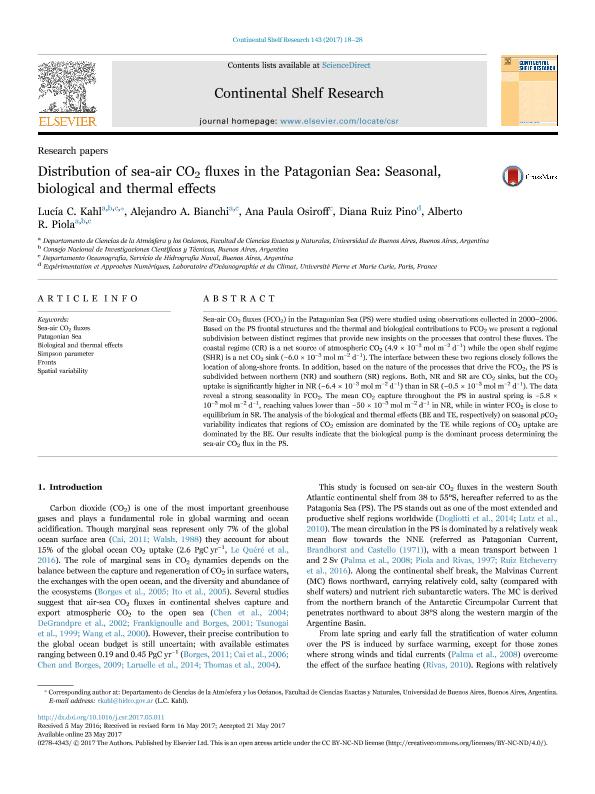Artículo
Distribution of sea-air CO 2 fluxes in the Patagonian Sea: Seasonal, biological and thermal effects
Kahl, Lucía Carolina ; Bianchi, Alejandro A.; Osiroff, Ana Paula; Pino, Diana Ruiz; Piola, Alberto Ricardo
; Bianchi, Alejandro A.; Osiroff, Ana Paula; Pino, Diana Ruiz; Piola, Alberto Ricardo
 ; Bianchi, Alejandro A.; Osiroff, Ana Paula; Pino, Diana Ruiz; Piola, Alberto Ricardo
; Bianchi, Alejandro A.; Osiroff, Ana Paula; Pino, Diana Ruiz; Piola, Alberto Ricardo
Fecha de publicación:
07/2017
Editorial:
Pergamon-Elsevier Science Ltd
Revista:
Continental Shelf Research
ISSN:
0278-4343
Idioma:
Inglés
Tipo de recurso:
Artículo publicado
Clasificación temática:
Resumen
Sea-air CO2 fluxes (FCO2) in the Patagonian Sea (PS) were studied using observations collected in 2000-2006. Based on the PS frontal structures and the thermal and biological contributions to FCO2 we present a regional subdivision between distinct regimes that provide new insights on the processes that control these fluxes. The coastal regime (CR) is a net source of atmospheric CO2 (4.9 x 10-3mol.m-2.d-1) while the open shelf regime (SHR) is a net CO2 sink (-6.0 x 10-3mol.m-2.d-1). The interface between these two regions closely follows the location of along-shore fronts. In addition, based on the nature of the processes that drive the FCO2, the PS is subdivided between northern (NR) and southern (SR) regions. Both, NR and SR are CO2 sinks, but the CO2 uptake is significantly higher in NR (-6.4 x 10-3mol.m-2.d-1) than in SR (-0.5 x 10-3mol.m-2.d-1). The data reveal a strong seasonality in FCO2. The mean CO2 capture throughout the PS in austral spring is -5.8 x 10-3mol.m-2.d-1, reaching values lower than -50 x 10-3mol.m-2.d-1 in NR, while in winter FCO2 is close to equilibrium in SR. The analysis of the biological and thermal effects (BE and TE, respectively) on seasonal pCO2 variability indicates that regions of CO2 emission are dominated by the TE while regions of CO2 uptake are dominated by the BE. Our results indicate that the biological pump is the dominant process determining the sea-air CO2 flux in the PS.
Archivos asociados
Licencia
Identificadores
Colecciones
Articulos(SEDE CENTRAL)
Articulos de SEDE CENTRAL
Articulos de SEDE CENTRAL
Citación
Kahl, Lucía Carolina; Bianchi, Alejandro A.; Osiroff, Ana Paula; Pino, Diana Ruiz; Piola, Alberto Ricardo; Distribution of sea-air CO 2 fluxes in the Patagonian Sea: Seasonal, biological and thermal effects; Pergamon-Elsevier Science Ltd; Continental Shelf Research; 143; 7-2017; 18-28
Compartir
Altmétricas



